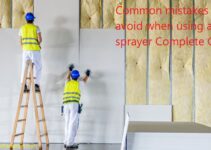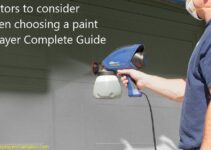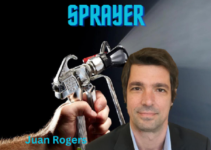Are you looking for a professional-looking paint job without the mess and hassle of a normal spray can or roller? Then an airless paint sprayer is the perfect tool for you!
In this article, you will learn all about airless paint sprayers, how they work and when to use them. Come with us on this journey and discover why these powerful tools are quickly becoming the choice of professionals!
Airless paint sprayers are a popular painting tool that saves time, applies a smooth finish and helps create even coats. However, despite their many advantages, airless paint sprayers can also be dangerous if used improperly.
In this guide, we’ll cover all the basics you need to know about airless paint sprayers – how they work, why and when to use them and some vital safety tips.
Ready to get started? Let’s take a look!
Explanation of airless paint sprayers
Airless paint sprayers are a type of paint spraying device that uses high pressure to atomize paint into tiny droplets and apply it onto surfaces. Unlike conventional compressed-airsprayers, which rely on the pressurized air released from a compressor or other means of propulsion to generate an even, controllable spray pattern, airless paint sprayers use piston pumps or diaphragm pumps to push the paint material through a small tip at very high pressures. This enables the user to create an even, consistent coating with minimal overspray or bounce-back, resulting in a much higher level of accuracy and efficiency than would be possible with an air-based system.
Airless paint sprayers are ideal for large painting jobs such as exterior walls and ceilings, as the powerful output of the sprayer makes quick work of these large areas. They also deliver a consistent coating thickness, making them well suited for projects requiring precise coverage such as automotive painting and delicate furniture pieces. Additionally, airless machines are relatively inexpensive compared to their compressed-air counterparts and require little maintenance once initial set up has been completed.
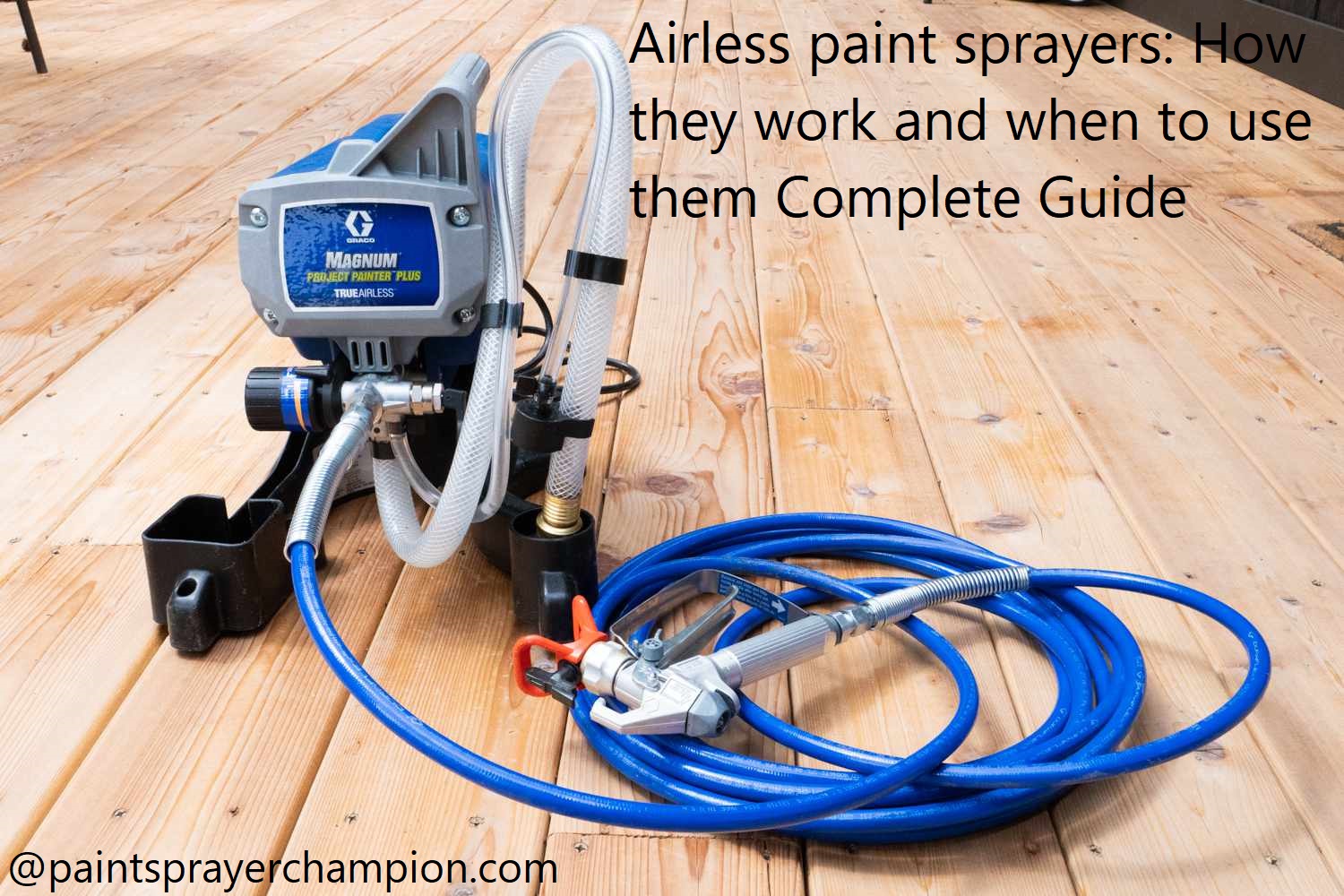
Importance of using airless paint sprayers
Airless paint sprayers are becoming increasingly popular among homeowners, contractors and professionals due to their convenience and efficiency. Airless paint sprayers provide an even finish with minimal overspray—which helps save time and money. They also allow for greater control over the amount of paint that is applied, which can be helpful for working on intricate details or irregular surfaces. Airless sprayers are a great tool to use for large projects like painting the exterior of a house or staining a deck, as well as smaller projects such as painting furniture or touch-ups around the home.
Using airless sprayers can help cut down on time spent painting since they have the ability to cover more area in less time than traditional methods of applying paint. Airless paint gun systems typically consist of three components—a motor, a pump and a hose — that work together to atomize paints into small particles (droplets) prior to spraying them onto surfaces. This process creates an even layer of coverage that eliminates brush strokes or roller marks and distributes more consistent amounts of color over wide areas when painting walls or surfaces with irregular shapes.
The power behind airless paint sprayers comes from their high operating pressure; this means that these machines are capable of pushing more material at higher speeds than ordinary compressed air equipment can achieve. To create this powerful delivery system without adding too much weight, it is important to use lightweight materials like aluminum or plastic body parts. The added benefits here are that airless machines are able to produce results with less overspray than other types of equipment, meaning fewer clean up efforts after finishing projects!
Purpose of the guide
This guide will provide information about airless paint sprayers, how they work and how their use can benefit a variety of situations. It is our goal to provide readers with a comprehensive overview of the advantages offered by the use of an airless sprayer, as well as a complete set of guidelines for the proper use and maintenance of this piece of equipment.
From choosing the right model for your needs to covering considerations related to usage, safety and environmental protection, this guide is intended to serve as a reliable reference source in your painting decisions. Whether you’re looking for information on airless paint sprayers or simply looking for advice on how to ensure that your painting projects are conducted with purpose and precision, we hope that this guide will serve you well.
Components of an Airless Paint Sprayer
An airless paint sprayer consists of a few discrete components that combine to make painting projects go faster and smoother. Most airless paint sprayers have a hose and wand assembly, suction tube, motor housing, control valves and an inlet spray control valve. Here’s a breakdown of the parts found on most standard models.
Hose and Wand Assembly: Hoses are generally made from reinforced rubber or plastic material and measure around 75 feet long. The wand can vary in length based on the volume of paint you need to apply per task.
Suction Tube: This conduit runs from the lower body of the sprayer up to the controller where it connects with the pump’s intake valve. It’s often designed as detachable pieces so that storing or transporting it is easier.
Motor Housing: This component houses both an electric motor and pump which distributes paint from the reservoir to your project’s surface visually at-hand level.
Control Valves: Consisting of two levers—one for controlling pressure level,and another for turning on/off just enough for manipulating specific painting needs readily you are inclined to operate with namely maneuverable yet agility pulsation as long as suitable artwork maintenance is concerned with suffice uniformity within outcomes at large upon its application respectively.
Inlet Spray Control Valve: This part of your airless sprayer helps regulate paint flow to make sure each coat covers evenly without over sprayingpaint misting at all times though unsupervised interaction is yet not amicably advisable since risk turns out being much too imminent if otherwise precautionary measures are not sincerely considered accordingly prior any given segmental activities involved concurrent thereat!
Pump
Airless paint sprayers use a pumping system to atomize the paint in a fine mist. This allows for more efficient and faster painting.
The pump is powered either electrically or with a gasoline engine, depending on the type of sprayer used. In some models, the electric motor runs on a small air compressor; in others, an internal pump assembly draws from an attached reservoir of paint.
As the paint is forced through the spray tip at high pressure, it atomizes into tiny droplets that are propelled onto the surface. This ensures even coverage and helps reduce dripping and over-spraying. By varying the speed or pressure at which the paint is pumped through, you can dial in ideal viscosity and rates of flow for your particular application.
Hose
Airless paint sprayers use a hose to drive a piston pump that uses pressure to atomize the paint. This type of sprayer can be used with any kind of home or commercial painting project.
Hose-driven airless paint sprayers are an excellent choice for DIY projects in which you need to transport the sprayer from one location to another, such as when painting multiple rooms in a house or doing touch-ups on different surfaces throughout the property.
Hose-driven airless paint sprayers also deliver more power than handheld models, although they may still require less effort on your part. With this type of airless paint sprayer, you attach a long hose to the portable compressor instead of carrying around a bulky canister. This allows for more accurate pacing and the ability to cover larger areas without having to stop and refill regularly. In addition, most handheld models come with shorter hoses that limit mobility and reduce efficiency when dealing with intricate designs and patterns.
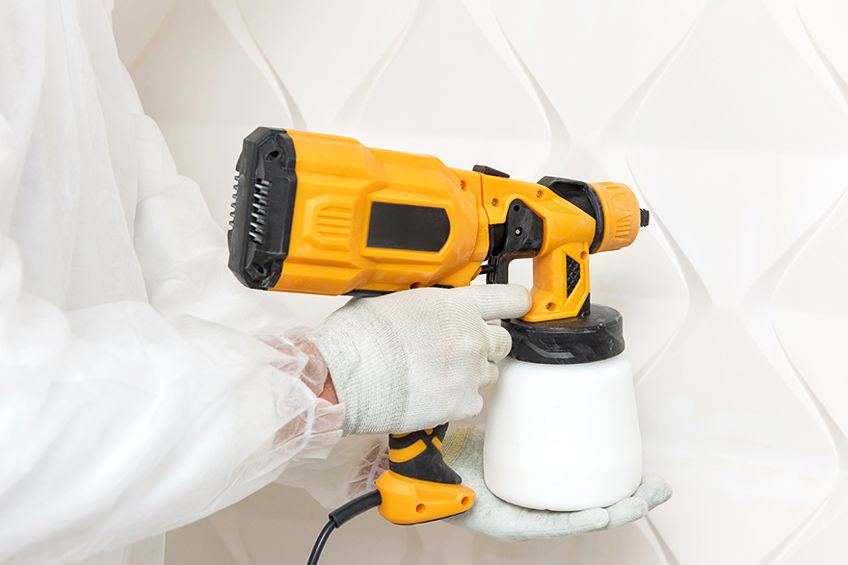
Gun
When spraying paint, a gun is used to create an aerosolized mist of pigment and binding agent. This mist is then atomized and propelled through the gun’s nozzle for application on the desired surface. Airless paint sprayers utilize a compressor to propel the paint particles which atomizes them with just enough pressure to allow them to adhere. Heavier coatings require more pressure for good coverage, so airless sprayers are generally better suited for heavier coatings such as interior house paints or primers.
An airless paint sprayer gives you greater control over the evenness of your finish because it doesn’t rely on air pressure levels to control output – allowing you to achieve more predictable results all around. Airless systems are also able to work faster than their air-powered counterparts, so they’re ideal for larger jobs where speed and evenness are important factors. However, they aren’t suitable for very small projects due to the often greater overspray that results from their use.
Nozzle
Nozzle size and design play a significant role in determining the pattern and size of the spray. Airless nozzles feature a round hole of a specific size, while conventional air-spray guns produce an oval, fan-shaped spray pattern.
Nozzles are configured to spray various materials: water-based coatings have smaller openings than oil-based products, as larger droplets may not break up and mix properly with the thinner vehicle. Nozzles rely on pressure developed by the pump to atomize the coating material; high pressures (1,000 psi) are needed for a fine finish. As a result, nozzle sizes range from 05 to 65, which refers to the opening in thousandths of an inch or mils (0.005” becomes 5 spray mil).
How Airless Paint Sprayers Work
Airless paint sprayers are powered by either a gas engine or an electric motor. When the machine is switched on, it takes pressurized air from an internal source and pushes it through a pump, resulting in an increase of pressure in the paint chamber. This pressure forces the paint out of the nozzle at a high velocity. Gas-powered sprayers usually have more power than electric sprayers, making them more suitable for larger jobs.
Once the paint is sprayed from the nozzle, it passes through several sets of fan blades that reduce the size of droplets and create a uniform spray pattern. The fan blades also help to create an even coating without leaving uneven patches on flat surfaces like walls and ceilings.
When using an airless sprayer, you should always wear protective gear such as safety glasses and a respirator to protect yourself from over-spray and inhaling toxic fumes generated by some paints and solvents. Also make sure that your workspace is properly ventilated in order to avoid any build up of hazardous fumes or vapors.
The airless spraying technique can be used with various types of finishes including enamels, stains, lacquers, primers and latex paints. However, because of its high-pressure capabilities make sure that you use only those recommended for use with airless equipment as other paints may not be compatible or may cause clogging due to their viscosity level or lack of solvents needed to thin them out in order to ensure compatibility with airless spraying equipment.
Explanation of the process
Airless paint sprayers are one of the most popular and effective ways to paint a surface. The process involves using an airless pump, pressure gun, and nozzle to atomize a thin layer of paint onto whatever surface you’re covering. This type of sprayer is typically used on larger projects because it can cover large areas quickly and evenly without leaving behind any excess paint or brush strokes.
The airless pump is first filled with the appropriate amount of paint, then it is attached to an airless gun/nozzle. The airless gun increases the pressure inside the pump, which in turn pushes the paint out through a small hole in the nozzle. As it comes out of the nozzle, it forms tiny droplets that spread over your surface as you move the gun back and forth across it.
Airless painting provides excellent coverage in less time than traditional methods, so it’s often used on larger projects such as houses or businesses. The downside to this method is that more overspray may occur, so protective clothing and equipment should always be worn while painting with an airless sprayer. Additionally, more clean-up may be needed after you finish spraying since overspray can drift further than expected due to wind or other environmental factors.
Differences between airless and traditional sprayers
Airless spraying takes advantage of a more advanced technology than traditional methods of painting. The method comprises a pressurized container with no air intake, as opposed to a traditional paint sprayer with an air compressor attached. The difference is that airless sprayers do not require the operator to mix the paint with any solvents or reduce viscosity for better flow. This makes it easier and faster to get the job done.
Airless sprayers are often preferred in contexts where traditional sprayers may be unable to reach its target. Airless sprayers create a more uniform coating, since the liquid being sprayed is atomized at a much higher pressure than that created by traditional paint sprayers, resulting in quicker coverage and fewer coatings required for finishing a job. Furthermore, since there is no need for an air compressor to facilitate the process, noise levels are kept low; this makes them ideal for interior jobs. Airless spraying is also preferable when working with thicker paints like latexes which require high-pressure pumps and large tip sizes due to their viscosity that can’t be reduced through thinning or mixing agents.
On the flipside, this advanced technology comes at an added cost in terms of operational costs as it requires more maintenance as well as expending more power (in terms of electricity usage) to facilitate its pressurizing capabilities.

Conclusion
In conclusion, airless paint sprayers can be a great tool for professionals and DIYers. By using an airless paint sprayer, you can reduce the time it takes to paint a wide variety of surfaces and materials. You’ll be able to get the job done quickly with perfectly even coverage and a beautiful finish. Many airless paint sprayers are available on the market, so you can find the right machine for your project needs.
It is important, however, to ensure that you choose the right material for your project. Certain types of paints or varnishes may require a different system than what is needed foe an airless sprayer; consult with an experienced professional if you are unsure which type of machine will be most suitable. Additionally, take all safety precautions while operating the airless paint sprayer; this is especially true if it’s your first time using one of these spraying machines!
FAQ’S
When should you use an airless sprayer?
An airless sprayer is best used for large projects that require a lot of coverage in a short amount of time. It is also ideal for thicker coatings such as exterior paints, stains, and varnishes.
What is an airless paint sprayer used for?
An airless paint sprayer is used for applying paint quickly and efficiently over large surfaces, such as walls, ceilings, fences, and decks.
When should you use a paint sprayer?
A paint sprayer is best used when you need to cover a large surface area quickly and evenly. It is also ideal for intricate projects that require detailed work, such as cabinets, furniture, and trim.
When and how to use a sprayer?
A sprayer should be used when you want to apply paint quickly and evenly over a large surface area. It is important to follow the manufacturer’s instructions for proper use and safety precautions.
What are the disadvantages of airless spray?
The disadvantages of airless spray include overspray, which can lead to wasted paint and messy work areas. It can also be more difficult to control the thickness of the coating, which may result in uneven coverage.
How long can paint sit in an airless sprayer?
Paint can typically sit in an airless sprayer for up to 24 hours without drying out, as long as the sprayer is properly sealed and stored in a cool, dry place.
Which is better air or airless paint sprayer?
The choice between air or airless paint sprayer depends on the project and personal preference. Airless sprayers are best for large projects and thick coatings, while air sprayers are better for smaller projects and finer finishes.
Is spraying better than painting?
Spraying can be better than traditional painting methods in terms of speed and efficiency, but it may not always provide the best finish or control over the application.
What is the benefit of paint sprayer?
The benefits of a paint sprayer include faster application times, even coverage, and the ability to reach tight spaces and corners.
What are the 4 types of paint sprayers?
The four types of paint sprayers are airless, HVLP (high volume low pressure), LVLP (low volume low pressure), and conventional (air) sprayers.
See Also:
- Best hvlp paint sprayer
- Best paint sprayer for cabinets
- Best cordless paint sprayer
- Best paint sprayer attachment for air compressor
- Best airless paint sprayer
